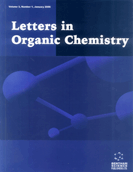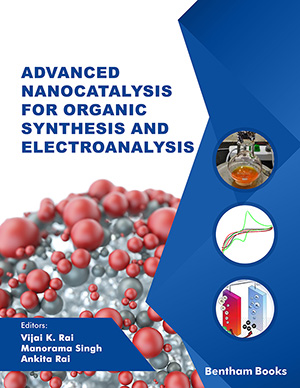[1]
Foroumadi, A.; Emami, S.; Hassanzadeh, A.; Rajaee, M.; Sokhanvar, K.; Moshafi, M.H.; Shafiee, A. Synthesis and antibacterial activity of N-(5-benzylthio-1,3,4-thiadiazol-2-yl) and N-(5-benzylsulfonyl-1,3,4-thiadiazol-2-yl)piperazinyl quinolone derivatives. Bioorg. Med. Chem. Lett., 2005, 15(20), 4488-4492.
[2]
Jain, A.K.; Sharma, S.; Vaidya, A.; Ravichandran, V.; Agrawal, R.K. 1,3,4‐Thiadiazole and its derivatives: A review on recent progress in biological activities. Chem. Biol. Drug Des., 2013, 81(5), 557-576.
[3]
Dogan, H.N.; Duran, A.; Rollas, S.; Sener, G.; Uysal, M.K.; Gülen, D. Synthesis of new 2,5-Disubstituted-1,3,4-thiadiazoles and preliminary evaluation of anticonvulsant and antimicrobial activities. Bioorg. Med. Chem., 2002, 10(9), 2893-2898.
[4]
Hu, Y.; Li, C.Y.; Wang, X.M.; Yang, Y.H.; Zhu, H.L. 1,3,4-Thiadiazole: synthesis, reactions, and applications in medicinal, agricultural, and materials chemistry. Chem. Rev., 2014, 114(10), 5572-5610.
[5]
Matysiak, J. Biological and pharmacological activities of 1,3,4-thiadiazole based compounds. Mini Rev. Med. Chem., 2015, 15(9), 762-775.
[6]
Foroughifar, N.; Mobinikhaledi, A.; Ebrahimi, S.; Moghanian, H.; Bodaghi Fard, M.A.; Kalhor, M. Synthesis of a new class of azathia crown macrocycles containing two 1,2,4-triazole or two 1,3,4-thiadiazole rings as subunits. Tetrahedron Lett., 2009, 50(7), 836-839.
[7]
Ningegowda, R.; Shivananju, N.S.; Rajendran, P. Basappa; Rangappa, K.S.; Chinnathambi, A.; Li, F.; Achar, R.R.; Shanmugam, M.K.; Bist, P.; Alharbi, S.A.; Lim, L.H.K.; Sethi, G.; Priya, B.S. A novel 4,6-disubstituted-1,2,4-triazolo-1,3,4-thiadiazole derivative inhibits tumor cell invasion and potentiates the apoptotic effect of TNFα by abrogating NF-κB activation cascade. Apoptosis, 2017, 22(1), 145-157.
[8]
Radi, M.; Crespan, E.; Botta, G.; Falchi, F.; Maga, G.; Manetti, F.; Corradi, V.; Mancini, M.; Santucci, M.A.; Schenone, S.; Botta, M. Discovery and SAR of 1,3,4-thiadiazole derivatives as potent Abl tyrosine kinase inhibitors and cytodifferentiating agents. Bioorg. Med. Chem. Lett., 2008, 18(3), 1207-1211.
[9]
Almajan, G.L.; Innocenti, A.; Puccetti, L.; Manole, G.; Barbuceanu, S.; Saramet, I.; Scozzafava, A.; Supuran, C.T. Carbonic anhydrase inhibitors. Inhibition of the cytosolic and tumor-associated carbonic anhydrase isozymes I, II, and IX with a series of 1,3,4-thiadiazole- and 1,2,4-triazole-thiols. Bioorg. Med. Chem. Lett., 2005, 15(9), 2347-2352.
[10]
Fan, Z.; Yang, Z.; Zhang, H.; Mi, N.; Wang, H.; Cai, F.; Zuo, X.; Zheng, Q.; Song, H. Synthesis, crystal structure, and biological activity of 4-methyl-1,2,3-thiadiazole-containing 1,2,4-triazolo[3,4-b][1,3,4]thiadiazoles. J. Agric. Food Chem., 2010, 58(5), 2630-2636.
[11]
Moise, M.; Sunel, V.; Profire, L.; Popa, M.; Desbrieres, J.; Peptu, C. Synthesis and biological activity of some new 1,3,4-thiadiazole and 1,2,4-triazole compounds containing a phenyl alanine moiety. Molecules, 2009, 14(7), 2621-2631.
[12]
Foroumadi, A.; Kiani, Z.; Soltani, F. Antituberculosis agents VIII: Synthesis and in vitro antimycobacterial activity of alkyl α-[5-(5-nitro-2-thienyl)-1,3,4-thiadiazole-2-ylthio]acetates. Farmaco, 2003, 58(11), 1073-1076.
[13]
Serban, G.; Stanasel, O.; Serban, E.; Bota, S. 2-Amino-1,3,4-thiadiazole as a potential scaffold for promising antimicrobial agents. Drug Des. Devel. Ther., 2018, 12, 1545-1566.
[14]
El-Sayed, W.A.; Fathi, N.M.; Gad, W.A.; El Ashry, E.S.H. Synthesis and antiviral evaluation of some 5‐N‐arylaminomethyl‐2‐glycosy-lsulphanyl‐1,3,4‐oxadiazoles and their analogs against hepatitis A and herpes simplex viruses. J. Carbohydr. Chem., 2008, 27(6), 357-372.
[15]
Abdel-Aal, M.T.; El-Sayed, W.A.; El-Kosy, S.M.; El-Ashry, E.S.H. Synthesis and antiviral evaluation of novel 5-(N-arylaminomethyl-1,3,4-oxadiazol-2-yl) hydrazines and their sugars, 1,2,4-triazoles, tetrazoles and pyrazolyl derivatives. Arch. Pharm. Chem. Life Sci., 2008, 341(5), 307-313.
[16]
Abdel-Aal, M.T.; El-Sayed, W.A.; El-Ashry, E.S.H. Synthesis and antiviral evaluation of some sugar arylglycinoylhydrazones and their oxadiazoline derivatives. Arch. Pharm. Chem. Life Sci., 2006, 339(12), 656-663.
[17]
El Ashry, E.S.H.; Abdel-Rahman, A.; Rashed, N.; Awad, L.F.; Rasheed, H.A. Synthesis of AZT analogues: 7-(3-azido-2-hydroxypropyl)-, 7-(3-amino-2-hydroxypropyl)-, 7-(3-triazolyl-2-hydroxypropyl)theophyllines. Nucleosides Nucleotides and Nucleic Acids, 2006, 25(3), 299-305.
[18]
El Ashry, E.S.H.; Rashed, N.; Awad, L.F.; Ramadan, E.; Abdel-Maggeed, S.M.; Rezki, N. Synthesis of 5‐aryl‐3‐glycosylthio‐4‐phe-nyl‐4H‐1,2,4‐triazoles and their acyclic analogs under conventional and microwave conditions. J. Carbohydr. Chem., 2008, 27(2), 70-85.
[19]
Cho, N.S.; Kim, G.N.; Párkányi, C. Synthesis of 5‐aroyl-amino‐3H‐1,3,4‐thiadiazole‐2‐thiones and their tautomerism. J. Heterocycl. Chem., 1993, 30(2), 397-401.
[20]
Shoda, S.; Moteki, M.; Izumi, R.; Noguchi, M. An environmentally benign and practical synthesis of sugar orthoesters promoted by potassium fluoride. Tetrahedron Lett., 2004, 45(48), 8847-8848.
[21]
Yang, Z.; Lin, W.; Yu, B. Rearrangement of sugar 1,2-orthoesters to glycosidic products: A mechanistic implication. Carbohydr. Res., 2000, 329(4), 879-884.
[22]
Banoub, J.; Bundle, D.R. 1,2-Orthoacetate intermediates in silver trifluoro-methanesulphonate promoted Koenigs–Knorr synthesis of disaccharide glycosides. Can. J. Chem., 1979, 57(16), 2091-2097.
[23]
Garegg, P.J.; Konradsson, P.; Kvarnstrom, I.; Norberg, T.; Svensson, S.C.T.; Wigilius, B. Studies on koenigs-knorr glycosidations. Acta Chem. Scand. B, 1985, 39, 569-577.
[24]
Sjolin, P.; Kihlberg, J. Use of fluorobenzoyl protective groups in synthesis of glycopeptides: β-elimination of O-linked carbohydrates is suppressed. J. Org. Chem., 2001, 66(9), 2957-2965.
[25]
Sharma, O.P.; Bhat, T.K. DPPH antioxidant assay revisited. Food Chem., 2009, 113(4), 1202-1205.
[26]
Amin, B.; Hajhashemi, V.; Abnous, K.; Hosseinzadeh, H. Ceftriaxone, a beta-lactam antibiotic, modulates apoptosis pathways and oxidative stress in a rat model of neuropathic pain. BioMed Res. Int., 2014, 2014Article ID 937568
[27]
Božić, A.R.; Filipović, N.R.; Novaković, I.T.; Bjelogrlić, S.K.; Nikolić, J.B.; Drmanić, S.Z.; Marinković, A.D. Synthesis, antioxidant and antimicrobial activity of carbohydrazones. J. Serb. Chem. Soc., 2017, 82(5), 495-508.
[28]
Božić, A.; Marinković, A.; Bjelogrlić, S.; Todorović, T.R.; Cvijetić, I.N.; Novaković, I.; Muller, C.D.; Filipović, N.R. Quinoline based mono- and bis-(thio)carbohydrazones: Synthesis, anticancer activity in 2D and 3D cancer and cancer stem cell models. RSC Adv., 2016, 6(106), 104763-104781.
[29]
Lipinski, C.A. Lead- and drug-like compounds: the rule-of-five revolution. Drug Discov. Today. Technol., 2004, 1(4), 337-341.
[30]
Veber, D.F.; Johnson, S.R.; Cheng, H.Y.; Smith, B.R.; Ward, K.W.; Kopple, K.D. Molecular properties that influence the oral bioavailability of drug candidates. J. Med. Chem., 2002, 45(12), 2615-2623.
[31]
Ritchie, T.J.; Macdonald, S.J.F. The impact of aromatic ring count on compound developability – are too many aromatic rings a liability in drug design? Drug Discov. Today, 2009, 14(21-22), 1011-1120.


























